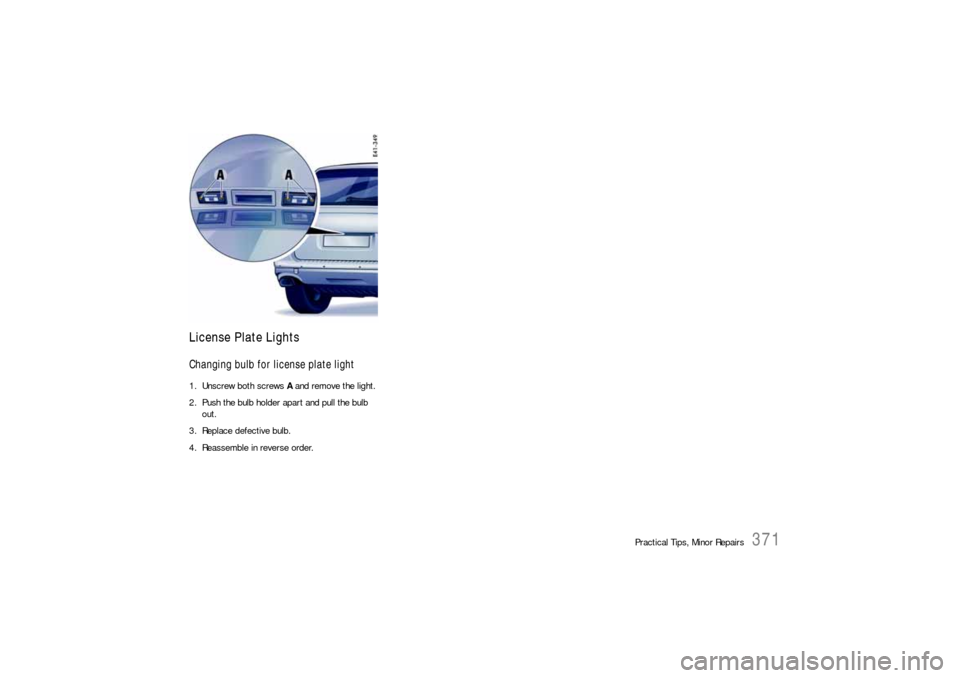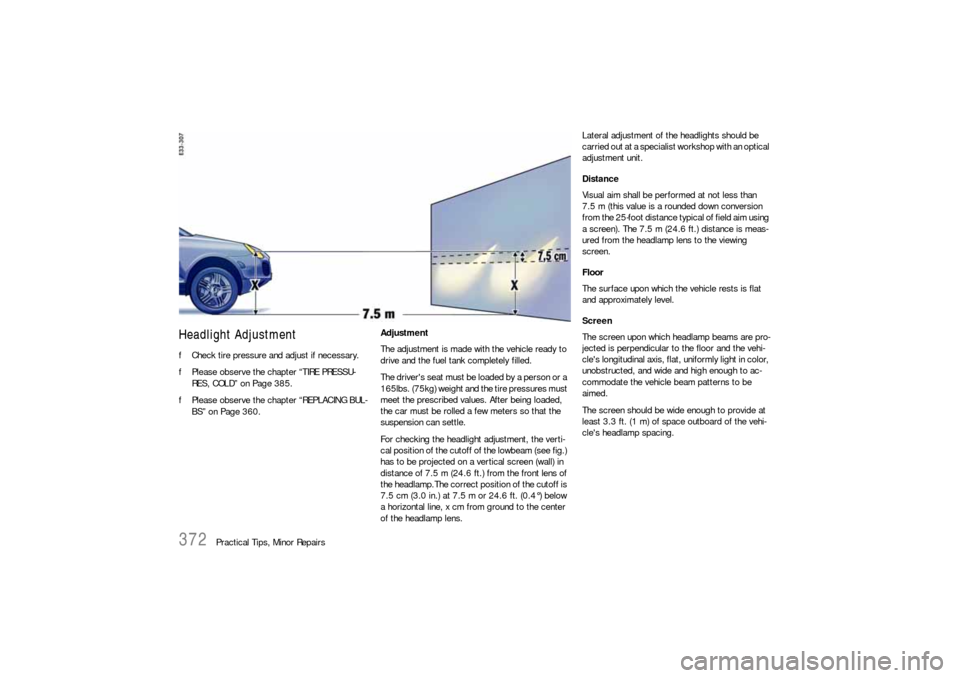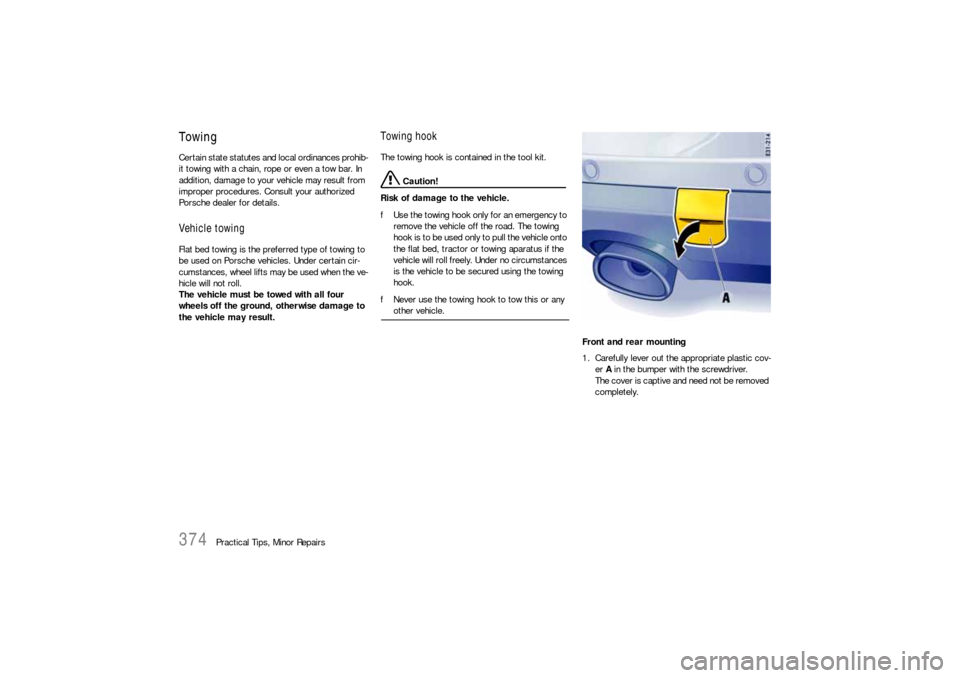PORSCHE CAYNNE S 2006 1.G Owners Manual
Manufacturer: PORSCHE, Model Year: 2006, Model line: CAYENNE S, Model: PORSCHE CAYENNE S 2006 1.GPages: 420, PDF Size: 3.81 MB
Page 371 of 420

Practical Tips, Minor Repairs
371
License Plate LightsChanging bulb for license plate light1. Unscrew both screws A and remove the light.
2. Push the bulb holder apart and pull the bulb
out.
3. Replace defective bulb.
4. Reassemble in reverse order.
Page 372 of 420

372
Practical Tips, Minor Repairs
Headlight AdjustmentfCheck tire pressure and adjust if necessary.
fPlease observe the chapter “TIRE PRESSU-
RES, COLD” on Page 385.
fPlease observe the chapter “REPLACING BUL-
BS” on Page 360.Adjustment
The adjustment is made with the vehicle ready to
drive and the fuel tank completely filled.
The driver's seat must be loaded by a person or a
165lbs. (75kg) weight and the tire pressures must
meet the prescribed values. After being loaded,
the car must be rolled a few meters so that the
suspension can settle.
For checking the headlight adjustment, the verti-
cal position of the cutoff of the lowbeam (see fig.)
has to be projected on a vertical screen (wall) in
distance of 7.5 m (24.6 ft.) from the front lens of
the headlamp.The correct position of the cutoff is
7.5 cm (3.0 in.) at 7.5 m or 24.6 ft. (0.4°) below
a horizontal line, x cm from ground to the center
of the headlamp lens.
Lateral adjustment of the headlights should be
carried out at a specialist workshop with an optical
adjustment unit.
Distance
Visual aim shall be performed at not less than
7.5 m (this value is a rounded down conversion
from the 25-foot distance typical of field aim using
a screen). The 7.5 m (24.6 ft.) distance is meas-
ured from the headlamp lens to the viewing
screen.
Floor
The surface upon which the vehicle rests is flat
and approximately level.
Screen
The screen upon which headlamp beams are pro-
jected is perpendicular to the floor and the vehi-
cle's longitudinal axis, flat, uniformly light in color,
unobstructed, and wide and high enough to ac-
commodate the vehicle beam patterns to be
aimed.
The screen should be wide enough to provide at
least 3.3 ft. (1 m) of space outboard of the vehi-
cle's headlamp spacing.
Page 373 of 420

Practical Tips, Minor Repairs
373
Height adjustment for low beam/
high beam and additional high beam1. Push down cover in the engine compartment
and remove.
2. Switch ignition on.
3. Switch on low beam and/or high beam.
4. Adjust low beam in direction of the arrow.
Changing Headlights from Left to
Right-Hand TrafficIf you travel to a corresponding country where traf-
fic uses the other side of the road, the headlights
must be partially masked with films when you
cross the border.
fYou can obtain the films and a set of instruc-
tions from an authorized Porsche dealer.
Page 374 of 420

374
Practical Tips, Minor Repairs
TowingCertain state statutes and local ordinances prohib-
it towing with a chain, rope or even a tow bar. In
addition, damage to your vehicle may result from
improper procedures. Consult your authorized
Porsche dealer for details.Vehicle towingFlat bed towing is the preferred type of towing to
be used on Porsche vehicles. Under certain cir-
cumstances, wheel lifts may be used when the ve-
hicle will not roll.
The vehicle must be towed with all four
wheels off the ground, otherwise damage to
the vehicle may result.
Towing hookThe towing hook is contained in the tool kit.
Caution!
Risk of damage to the vehicle.
fUse the towing hook only for an emergency to
remove the vehicle off the road. The towing
hook is to be used only to pull the vehicle onto
the flat bed, tractor or towing aparatus if the
vehicle will roll freely. Under no circumstances
is the vehicle to be secured using the towing
hook.
fNever use the towing hook to tow this or any other vehicle.
Front and rear mounting
1. Carefully lever out the appropriate plastic cov-
er A in the bumper with the screwdriver.
The cover is captive and need not be removed
completely.
Page 375 of 420

Practical Tips, Minor Repairs
375
2. Screw in towing hook B as far as the stop (left-
hand thread) and tighten hand-tight.
Pulling vehicle onto flat bed1. Position wooden ramps at the base of the flat
bed to reduce the angle of the pull.
2. Reel in the hoist cable and check the underside
of the vehicle for any interference.
Tying down vehicle on flat bed1. Carefully feed towing straps through the open-
ing in the rear wheels.
Make sure metal parts of straps do not dam-
age rim. Make sure the strap is flat over the
rim bead.
Make sure brake backing plate is not dam-
aged.
2. Secure straps to rear of flat bed.
3. Reel in hoist cable only far enough to tension
tie-down straps.
f f f
Page 376 of 420

376
Practical Tips, Minor Repairs 4. Carefully feed towing straps through the open-
ing in the front wheels.
Make sure metal parts of straps do not dam-
age rim.
Make sure the strap is flat over the rim bead.
Make sure brake backing plate is not dam-
aged.
5. Secure straps to front of flat bed.
6. Release tension on hoist cable, but do not dis-
connect. Use hoist cable as a safety cable.
Recovering the vehicleDepending on the vehicle equipment, the spare-
wheel well contains one or two towing lugs.
fWhen recovering the vehicle, always use two
towing lugs if possible.
Screw in the towing lugs only at the front or
rear.
Never screw them in so that one towing lug is
at the front and one is at the back.
Page 377 of 420

Vehicle Identification, Technical Data
377 Vehicle Identification, Technical Data
Vehicle Identification................................... 378
Engine Data ............................................... 380
Transmission ............................................. 381
Tires, Rims, Tracks .................................... 382
Tire Pressures, Cold................................... 385
Capacities ................................................. 386
Weights ..................................................... 387
Driving Performance................................... 388
Dimensions ................................................ 389
Ground Clearance ...................................... 390
Page 378 of 420

378
Vehicle Identification, Technical Data
Vehicle IdentificationWhen ordering spare parts or making inquiries,
please always quote the vehicle identification
number.Data bankThe data bank is located in the passenger com-
partment below the steering wheel. It contains all
important data about your car.This label contains the following information:
1. Vehicle Identification No.
2. Type/Type description
3. Engine code/Transmission code
4. Paint No./Interior
5. Optional equipment
A duplicate of this label is in your Maintenance
Booklet.
Note
The data bank can not be reordered when lost or
damaged.
Vehicle identification numberIn accordance with Federal Safety Regulations,
the vehicle identification number of your car is lo-
cated at the bottom left of the windshield frame
and can be seen from the outside and in the lug-
gage compartment on the right in front of the tool
box.
Page 379 of 420

Vehicle Identification, Technical Data
379
Safety compliance stickerThe safety compliance sticker is your assurance
that your new Porsche complies with all applicable
Federal Motor Vehicle Safety Standards which
w e re i n e f f e c t a t t h e t ime the vehicle was manufac-
tured.
The sticker also shows the month and year of pro-
duction and the vehicle identification number of
your car (perforations) as well as the Gross Vehi-
cle Weight Rating and the Gross Axle Weight Rat-
ing.
Tire pressure plateThe tire pressure plate is fitted to the driver's
door.
Page 380 of 420

380
Vehicle Identification, Technical Data
Engine Data
Cayenne
manual transmissionCayenne
Tiptronic SCayenne S
manual transmissionCayenne S
Tiptronic S
Ty p e
6-cylinder V-engine
6-cylinder V-engine
8-cylinder V-engine
8-cylinder V-engine
Number of cylinders 6688
Bore
33.09 in. (84 mm)
33.09 in. (84 mm)
3.66 in. (93 mm)
3.66 in. (93 mm)
Stroke 37.78 in. (95.9 mm) 37.78 in. (95.9 mm) 3.27 in. (83 mm) 3.27 in. (83 mm)
Displacement
195 cu. in. (3189 cm
3)195 cu. in. (3189 cm
3)275 cu. in. (4511 cm
3)275 cu. in. (4511 cm
3)
Net-horsepower, SAE J 1349 184 kW (250 HP) 184kW (250 HP) 250 kW (340 HP) 250 kW (340 HP)
at engine speed
6000 rpm
6000 rpm
6000 rpm
6000 rpm
Net. torque, SAE J 1349 229 ftlb. (310 Nm) 229 ftlb. (310 Nm) 310 ftlb. (420 Nm) 310 ftlb. (420 Nm)
at engine speed
2500 - 5500 rpm
2500 - 5500 rpm
2500 - 5500 rpm
2500 - 5500 rpm
Maximum permitted engine speed 6700 rpm 6700 rpm 6700 rpm 6500 rpm